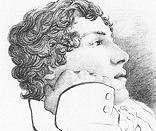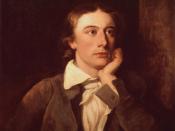"To Autumn" was a poem written by the romantic poet John Keats, after walking through the water meadows of Winchester, England, in an early autumn evening of 1819.The poem features many a Romantic qualities, particularly through its use of corporeal imagery which appeals to all aspects of the human senses. The time the poem was written is crucial to its interpretation, as behind Keats' vivid use of description and imagery lies a much deeper message. Keats is not just talking about autumn; he is talking about life, and more relevantly, the end of it. 'To Autumn' clearly expresses Keats' knowledge of his inevitable, and rapidly approaching death. The three stanzas of the poem each carry a unique significance to the message Keats is illustrating. All three consist of eleven lines, and each stanza starts with an alternate rhyme scheme. Stanza one represents the beginning of not just autumn, but of a day, and most importantly of life.
'Season of mists and mellow fruitfulness 'Keats uses a metaphor to name autumn again, this time adding an element of personification by calling the season the maturing sun's 'close bosom-friend' and attributing to these friends the capacity of conspiring together. 'Conspiring with him how to load and bless' Autumn and the sun make so many flowers bud late in the season that the bees have become confused: 'Until they think warm days will never cease, For summer has o'er-brimmed their clammy cells' This stanza too is addressed to Autumn. It begins with a question, 'Who hath not seen thee oft amid thy store? The question is a rhetorical one, as Keats is stressing the fact that everyone has seen Autumn.
Stanza two slows down and contains almost no movement. Autumn, personified as a reaper or a harvester, crosses...



Great
You did a great job.........:)
0 out of 1 people found this comment useful.